Order Sphenisciformes Rank Species | Phylum Chordata Family Spheniscidae Scientific name Aptenodytes patagonicus Higher classification Aptenodytes | |
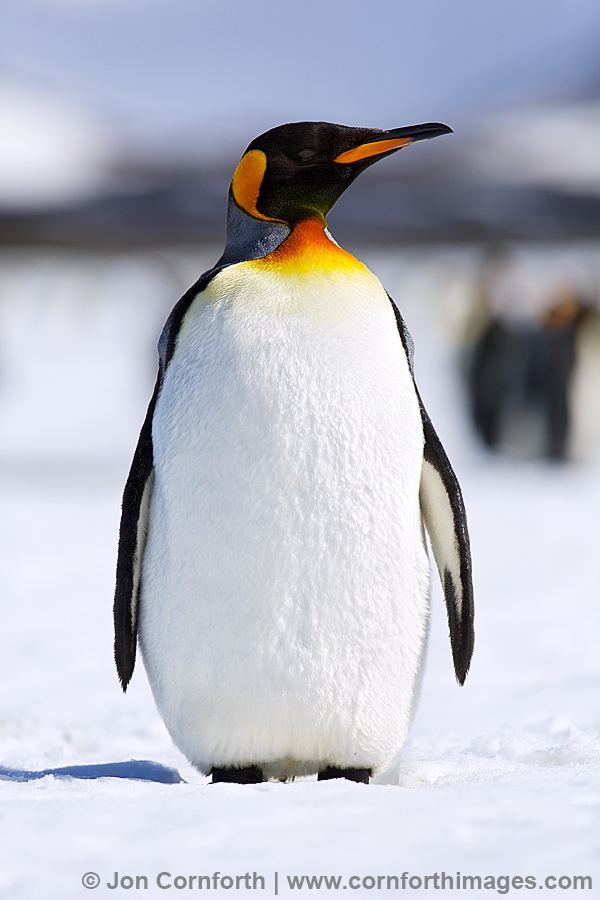 | ||
Similar Penguin, Emperor penguin, Aptenodytes, Adélie penguin, Gentoo penguin | ||
The king penguin (Aptenodytes patagonicus) is a large species of penguin, second only to the emperor penguin in size. There are two subspecies: A. p. patagonicus and A. p. halli; patagonicus is found in the South Atlantic and halli elsewhere.
Contents
- Description
- Distribution and habitat
- Behavior
- Diet
- Predators
- Courtship and breeding
- Relationship with humans
- Notable king penguins
- References
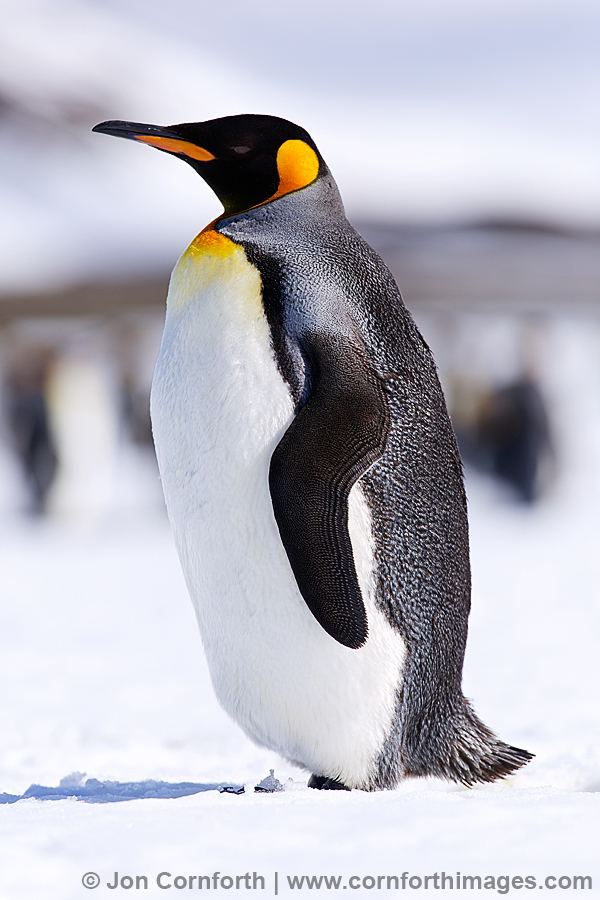
King penguins eat small fish, mainly lanternfish, and squid. They are less reliant on krill and other crustaceans than most Southern Ocean predators. On foraging trips king penguins repeatedly dive to over 100 metres (300 ft), and have been recorded at depths greater than 300 metres (1,000 ft).
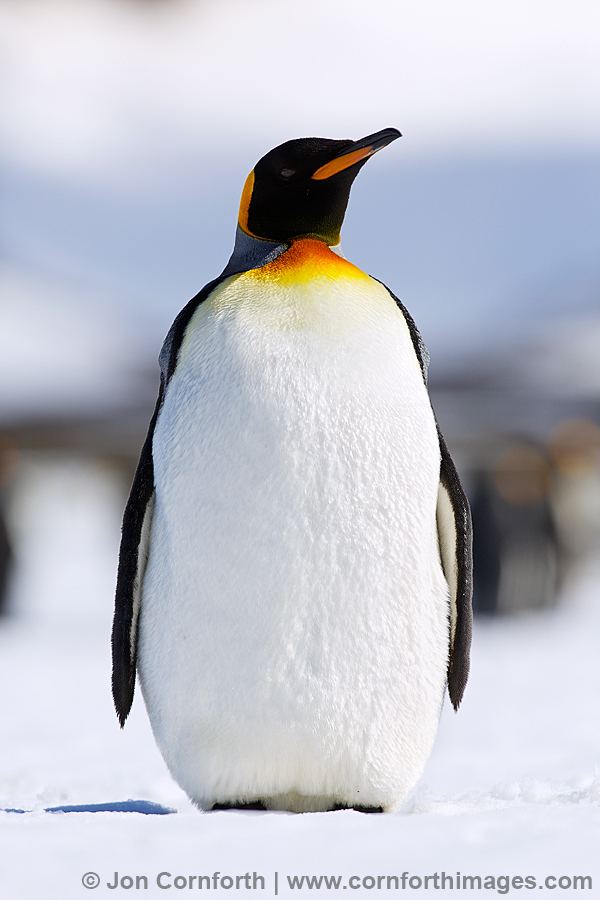
King penguins breed on the subantarctic islands at the northern reaches of Antarctica, South Georgia, and other temperate islands of the region.
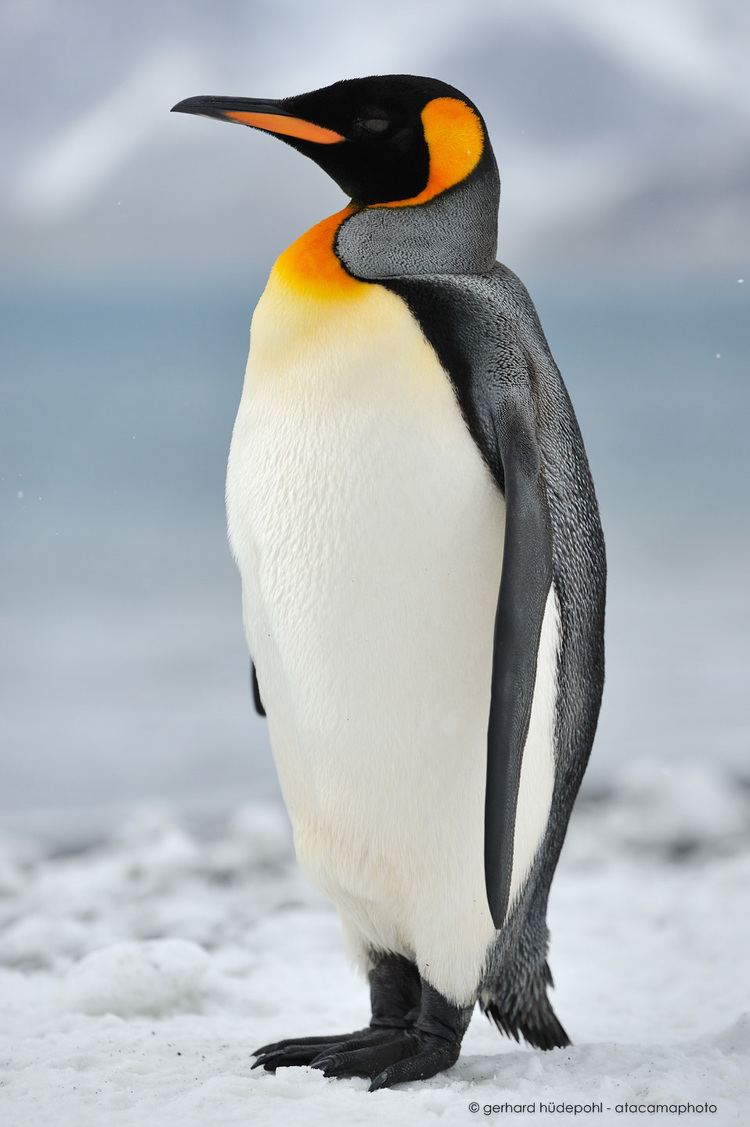
Description
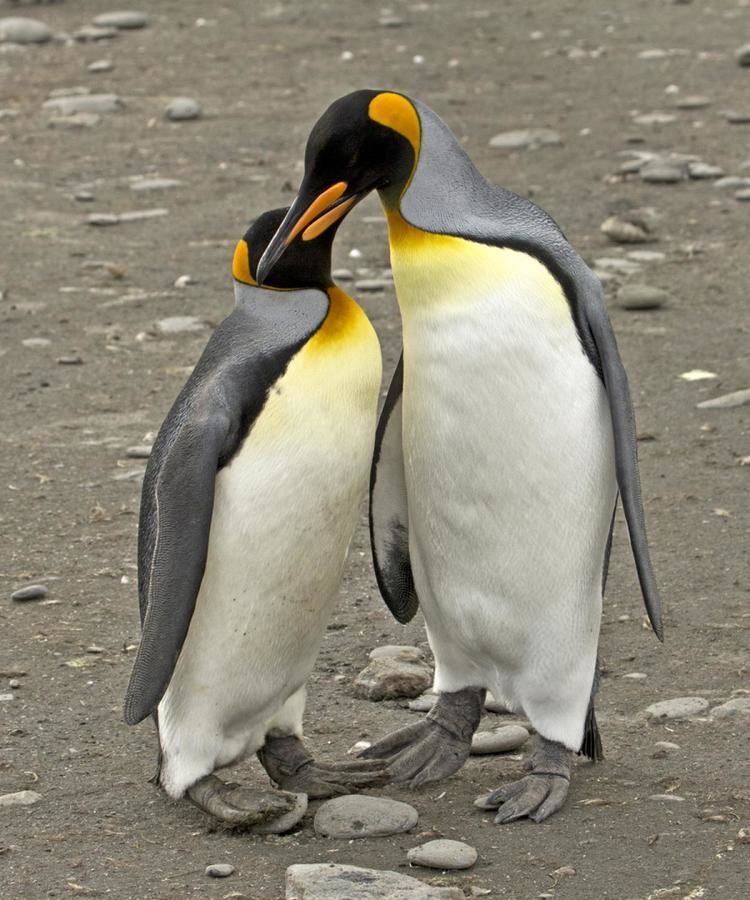
The king penguin stands at 70 to 100 cm (28 to 39 in) tall and weighs from 9.3 to 18 kg (21 to 40 lb). Males are slightly larger than females. The mean body mass of adults from Marion Island was 12.4 kg (27 lb) for 70 males and 11.1 kg (24 lb) for 71 females. Another study from Marion Island found that the mean mass of 33 adults feeding chicks was 13.1 kg (29 lb). Thus the average weight of the king penguin is similar or just slightly higher than that of the largest living flying birds. The plumage of the king penguin is broadly similar to that of the closely related emperor penguin, with a broad cheek patch contrasting with surrounding dark feathers and yellow-orange color at the top of the chest, however the cheek patch of the adult king penguin is bright orange whereas that of the emperor penguins is white, while the chest orange tends to be more vivid and less yellowish in the king species. Both species have colorful markings along the side of their lower mandible, but these are pinkish in emperor penguins and orange in king penguins. Emperor and king penguins do not occur together in the wild typically, with the possible exception of vagrants at sea, but the emperor can readily be distinguished by being noticeably larger and bulkier. Once fully molted of its heavy dark brown down, the juvenile king penguin resembles the adult but is somewhat less colorful. King penguins often breed on the same large, circumpolar islands as at least half of all living penguins, but it is easily distinguished from co-occurring penguins by its much larger size and taller frame, distinctive markings and grizzled sooty-grayish rather than blackish back.
Distribution and habitat
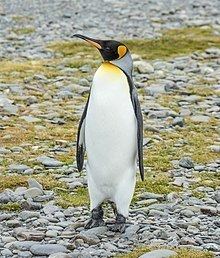
King penguins breed on subantarctic islands between 45 and 55°S, at the northern reaches of Antarctica, as well as Tierra del Fuego, the Falkland Islands, and other temperate islands of the region. The total population is estimated to be 2.23 million pairs and is increasing. The largest breeding populations are on the Crozet Islands, with around 455,000 pairs, 228,000 pairs on the Prince Edward Islands, 240,000–280,000 on the Kerguelen Islands and over 100,000 in the South Georgia archipelago. Macquarie Island has around 70,000 pairs. The non-breeding range is poorly known due to vagrant birds having been recorded from the Antarctic peninsula as well as South Africa, Australia and New Zealand.
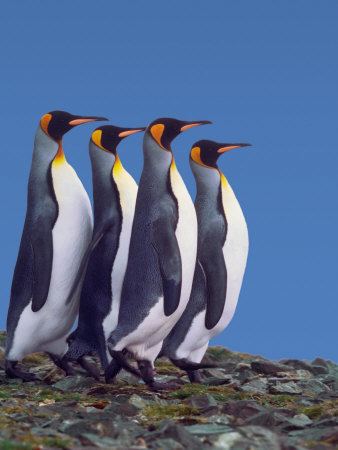
The Nature Protection Society released king penguins in Gjesvær in Finnmark, and Røst in Lofoten in northern Norway in August 1936. Birds were reported in the area several times in the 1940s though none have been seen since 1949.
Behavior
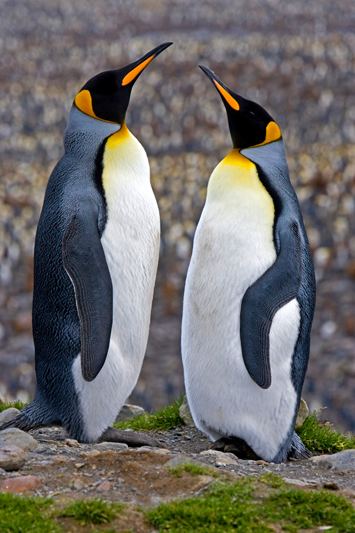
American zoologist Gerry Kooyman revolutionized the study of penguin foraging behaviour in 1971 when he published his results from attaching automatic dive-recording devices to emperor penguins, and recording a dive of 235 metres (771 ft) by a king penguin in 1982. The current maximum dive recorded is 343 metres in the Falkland Islands region, and a maximum time submerged of 552 seconds recorded at the Crozet Islands. The king penguin dives to depths of 100–300 meters (350–1000 feet), spending around five minutes submerged, during daylight hours, and less than 30 metres (98 ft) at night.
The majority (around 88% in one study) of dives undertaken by king penguins are flat-bottomed; that is, the penguin dives to a certain depth and remains there for a period of time hunting (roughly 50% of total dive time) before returning to the surface. They have been described as U-shaped or W-shaped, relating to the course of the dive. The bird dives in a V-shaped or "spike" pattern in the remaining 12% of dives; that is the bird dives at an angle through the water column, reaches a certain depth and then returns to the surface. Other penguins dive in this latter foraging pattern in contrast. Observations at Crozet Islands revealed most king penguins were seen within 30 km (19 mi) of the colony. Using the average swimming speed, Kooyman estimated the distance travelled to foraging areas at 28 km (17 mi).
Its average swimming speed is 6.5–10 km/h (4–6 mph). On shallower dives under 60 m (200 ft), it averages 2 km/h (1.2 mph) descending and ascending, while on deeper dives over 150 m (490 ft) deep, it averages 5 km/h (3.1 mph) in both directions. King penguins also porpoise, a swimming technique used to breathe while maintaining speed. On land, the king penguin alternates between walking with a wobbling gait and tobogganing—sliding over the ice on its belly, propelled by its feet and wing-like flippers. Like all penguins, it is flightless.
Diet
King penguins eat small fish and squid and rely less than most Southern Ocean predators on krill and other crustaceans. Fish constitute 80–100% of their diet, except in winter months of July and August, when they make up only 30%. Lanternfish are the main fish taken, principally the species Electrona carlsbergi and Krefftichthys anderssoni, as well as Protomyctophum tenisoni. Slender escolar (Paradiplospinus gracilis) of the Gempylidae, and Champsocephalus gunneri, is also consumed. Cephalopods consumed include those of the genus Moroteuthis, the hooked squid or Kondakovia longimana, the sevenstar flying squid (Martialia hyadesii), young Gonatus antarcticus and Onychoteuthis species.
Predators
The king penguin's predators include birds and aquatic mammals:
Courtship and breeding
The king penguin is able to breed at three years of age, although only a very small minority (5% recorded at Crozet Islands) actually do then; the average age of first breeding is around 6 years. King penguins are serially monogamous. They have only one mate each year, and stay faithful to that mate. However, fidelity between years is only about 29%. The long breeding cycle may contribute to this low rate.
The king penguin has an unusually prolonged breeding cycle, taking some 14–16 months from laying to offspring fledging. Although pairs will attempt to breed annually, they are generally only successful one year in two, or two years in three in a triennial pattern on South Georgia. The reproductive cycle begins in September to November, as birds return to colonies for a prenuptial moult. Those that were unsuccessful in breeding the previous season will often arrive earlier. They then return to the sea for three weeks before coming ashore in November or December. The female penguin lays one pyriform (pear-shaped) white egg weighing 300 g (⅔ lb). It is initially soft, but hardens and darkens to a pale greenish colour. It measures around 10 cm × 7 cm (3.9 in × 2.8 in). The egg is incubated for around 55 days with both birds sharing incubation in shifts of 6–18 days each. Hatching may take up to 2–3 days to complete, and chicks are born semi-altricial and nidicolous. In other words, they have only a thin covering of down and are entirely dependent on their parents for food and warmth. The guard phase starts with the birth of the chick. The young chick spends its time balanced on its parents' feet, sheltered by a pouch formed from the abdominal skin of the latter. During this time, the parents alternate every 3–7 days, one guarding the chick while the other forages. The guard phase lasts for 30–40 days. By then the chick has grown much bigger, can keep itself warm and protect itself against most predators. It becomes more curious and starts to explore its surroundings. It ends up forming a group with other chicks, a so-called crèche. Crèches are guarded by only a few adult birds; most parents can leave their chick to forage for themselves and their chick. Other species of penguins also practice this method of communal care for offspring.
By April the chicks are almost fully grown, but lose weight by fasting over the winter months, gaining it again during spring in September. Fledging then takes place in late spring/early summer.
King penguins form huge breeding colonies; for example, the colony on South Georgia Island at Salisbury Plain holds over 100,000 breeding pairs and the one at St. Andrew's Bay over 100,000 birds. Because of the long breeding cycle, colonies are continuously occupied.
The king penguin feeds its chicks by eating fish, digesting it slightly and vomiting the food into the chick's mouth.
Because of their large size, king penguin chicks take 14–16 months before they are ready to go to sea. This is markedly different from smaller penguins, who rear their chicks through a single summer when food is plentiful. King penguins time their mating so the chicks will develop over the harshest season for fishing. In this way, by the time the young penguins are finally mature enough to leave their parents, it is summer when food is plentiful and conditions are more favorable for the young to survive alone.
Relationship with humans
Considered a flagship species, 176 individuals were counted in captivity in North American zoos and aquaria in 1999. The species has been bred in captivity at SeaWorld San Diego. The species is exhibited at SeaWorld Orlando, Indianapolis Zoo, Detroit Zoo, Saint Louis Zoo, Kansas City Zoo, Newport Aquarium in Newport, Kentucky, Edinburgh Zoo in Scotland, Berlin Zoological Garden in Germany, Zurich Zoo, in the Netherlands Diergaarde Blijdorp, in Switzerland, 63 Seaworld in Seoul, South Korea, Melbourne Aquarium in Australia, Mar del Plata Museum of the Sea in Argentina, Loro Parque in Spain and Ski Dubai in United Arab Emirates, Calgary Zoo in Canada, Odense Zoo in Denmark and many other collections.
The king penguin is the emblem of Edinburgh Zoo.
Roger Tory Peterson's ornithological nickname was "King Penguin".
